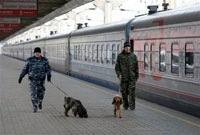Grieving Relatives Identify Victims of Passenger Train Crash
Over 60 relatives of those who died in the crash of the Nevsky Express passenger train arrived in Tver – a regional center, a city between Moscow and St. Petersburg, where the bodies of the victims had been delivered.

Psychological counseling was provided to all, who arrived in Tver for identification procedures, local officials said. The people presumably arrived from Moscow and St. Petersburg.
The passenger train crashed on Friday, November 27, at about 10:00 p.m. Twenty-six people were killed and 96 injured in the crash the cause of which was a terrorist act, Interfax reports.
471 people are currently working on the crash site to remove the damaged cars and repair the tracks. All the works are to be finished on Sunday night, at about 8:00 p.m.
The derailment was caused by an explosive device equivalent to 7 kg of TNT. Earlier reports said 26 people were dead, 96 injured and 18 missing in the train crash.
Meanwhile, Health and Social Development Minister Tatiana Golikova said there were six foreigners on board the train, with two of them, an Italian and a Belgian, injured in the crash. The data on the other four - an Azerbaijani, two Ukrainians and a Belarusian - were being specified, RIA Novosti news agency reports.
Golikova also said that 85 people were staying in hospitals after the deadly train crash.
A similar derailment, also caused by a bomb, occurred on the same route in August 2007, injuring around 60 people.
The blast has raised fears of a resurge of terrorist attacks in the Russian capital and other major cities. Russia was hit hard by terrorism in the 1990s and the early years of this decade, but violence has largely been confined to the volatile North Caucasus region since 2004.
The Moscow to Saint Petersburg Railway is a 649.7 km (403.7 mi) railway running between the two largest Russian cities of Moscow and Saint Petersburg, and through four oblasts: Moscow, Tver, Novgorod and Leningrad. It is the leading traffic artery for the whole of the north-west region of Russia, operated by Oktyabrskaya Railway subdivision of Russian Railways.
The current maximum speed on the Moscow-St. Petersburg line is 200 km/h (124 mph); the fastest train takes 4 hours and 30 minutes. However, construction works have been under way since 2004, which will take it to 250 km/h (155 mph). The Siemens-built Velaro RUS train, aka Sapsan, will debut operationally on this line in December 2009 with a maximum speed of 250 km/h (155 mph), but running below their capacity because of difficulties upgrading all the tracks. Nevertheless, it is expected that the Sapsans will trim the Moscow-to-St. Petersburg time to 3 hours and 45 minutes. For this Sapsan project, Russian Railways spent nearly $1 billion for its eight Siemens Velaro trains.
The future trainsets are already able to operate at 300 km/h (186 mph). They are widened versions of the Siemens Velaro 3rd generation ICE train, similar to the CRH3 in China.
Since 1931, a famous train, called the Krasnaya Strela ("Red Arrow"), has operated on this line, leaving Moscow (Leningradsky Rail Terminal) at 23:55 daily and arriving in Saint Petersburg (Moskovsky Rail Terminal) at 07:55 the next morning and vice-versa.
Subscribe to Pravda.Ru Telegram channel, Facebook, RSS!





